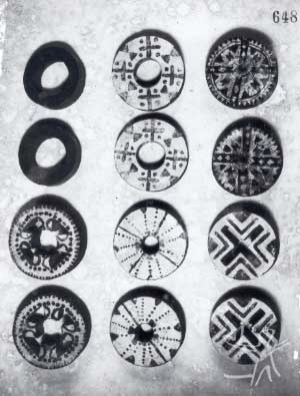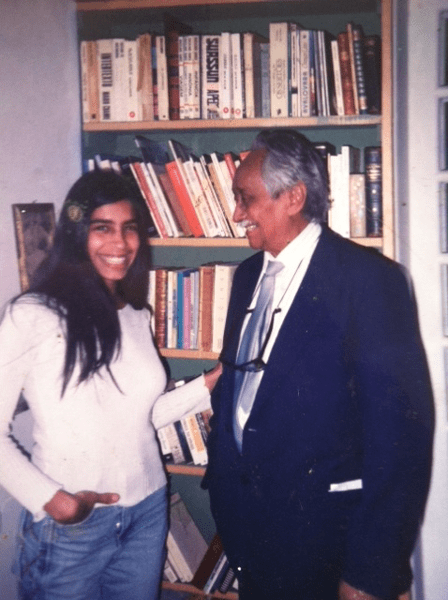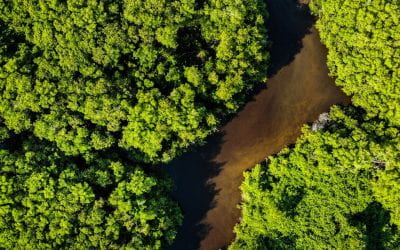The Canela and I
Making Nets of Translation and Tradition
For my granddaughter, Eloise Flor
A mestiça born in Brazil, I had many worlds from which to choose. I could have selected that of my Sicilian ancestors, those immigrant Librandis who came to São Paulo eager for honest work of nearly any sort. I also could have chosen the Hakimes, Syrian immigrants who make up the other half of my mother’s family. In the end, however, it was the mix of indigenous American, African and Portuguese people that constitute my father’s family that came to take hold of my intellectual and academic life.
From the time I was little, my mother’s family (all of whom shared my mother’s light skin) referred to me as indiazinha or negrinha, a fact that permanently marked my imaginary and endowed me with a sense of belonging to some unknown history. Raised by a single mother (a seldom-mentioned but common enough phenomenon in Brazil) in São Paulo, I was 18 when I finally met my father’s family, all of whom lived in Mato Grosso. When I arrived at the Cuiabá airport for the first time, I immediately recognized the older man waiting for me, though I had never seen him. This was my paternal grandfather, Joaquim Nunes Rocha (1916-2011), or “Seu Rochinha” as everyone there knew him. “How did you recognize me?” he asked. His cinnamon-colored skin and flowing black hair, a perfect mirror image of my father and uncles, had left me no doubt. I remember thinking at the time that I had found my people. Beyond this, I recognized in my father’s family the source of my own silence, so different from the urban and artistic expressiveness I knew in São Paulo.
A few years later, more or less when this photo was taken, my grandfather told me something that no one else in the family knew. We had all assumed that our indigenous Brazilian roots lay with the Boe-Bororos of Mato Grosso, but my grandfather revealed that our ancestors in fact came from Maranhão, and specifically from the Timbira-speaking Gê people known as the Canela. Just who my Canela ancestor might have been, from my grandfather’s maternal family, he never said. Perhaps he had no idea. It is likely that this information had been lost along with much of the ancient, forgotten past of the caboclos and pardos of Brazil’s vast Northeastern region. Born in the south of Maranhão, not far from the Lontra River (a tributary of the Araguaia River, and today part of the Brazilian state of Tocantins), my grandfather nonetheless grew up over a thousand miles from there: “After my father died, my mother, a very strong woman, boarded a batelão (a big canoe) with her kids and paddled upstream until we reached Poxoréu, Mato Grosso.” On that same day, my grandfather shared with me the last memory he had of his father: seriously ill and lying in a net hammock.
“The Canela Are Here!”
“The Canela are here!” my sister Fernanda texts me. It was July 2019, and I was attending a conference at the University of Brasilia. I had presented my new research on Brazilian literature and Amerindian thought, and I slipped outside as soon as I got my sister’s text. There in the parking lot was a small group of Canela from the village of Escalvado, in Maranhão. The women all spoke their native language, while a man standing next to them told me in Portuguese that they needed to sell their artwork to pay for their bus ride home. Among the items for sale was the beautiful ritual mask shown below.

Antônio Ropká Canela holds up a ritual mask. The Canela women with whom he’s traveling are seated next to him. Photo from author’s personal archive / Senhor Antônio Ropká Canela segura a máscara ritual. Arquivo pessoal
I eagerly recorded my conversation with the man, who told me in heavily accented Portuguese that his name was Antônio Ropká Canela. A portion of our conversation went like this:
—It is the decoration, it is for the culture, for the translation. Great-grandfather left it to me: ‘You have to use it; do not leave out translation, do not leave out this material.’ Translation is this thing that Great-grandfather left me. It is so much beauty, to strengthen the Indians, the Canela.
—And what is this mask called, Seu Antônio (a term of respect)?
—Transitional. You can use it in a dance, you can use it, you can sing; no one sees your face. The mask has its own celebration, its own songs.
—Do you remember any of these songs?
—I do. My great-grandfather taught me everything. [He sings.] A Canela does not forget his translation. He cannot forget.
Sometime later, I shared my recording with a friend, and she corrected what I thought I had heard, fine-tuning it. Seu Antônio had said tradition not translation, and he had said traditional not transitional. It occurred to me then that the tenuous relation between meaning, saying one thing (such as tradition and traditional), that can sound like something else (e.g., translation and transitional) constitutes a positive mistranslation.
This possibility invites with it an auditive theory of the transmission of tradition as equivocal translation (to paraphrase Brazilian anthropologist Eduardo Viveiros de Castro) or, conversely, a theory of translation as equivocal tradition. A tradition based on translation indexes one’s relation to the other, from outside and from another language, as an integral part of one’s relational identity (a distinctly Amerindian concept described in numerous ethnographies); and the object of tradition, the mask, is “transitional” insofar as it facilitates a crossing between worlds, both through the tradition of rituals and the interspecies diplomacy of shamans.
Curt Nimuendajú and the Kokrit Masks
It is this traditional/transitional form of life, intimately linked to the land, that is constantly under attack. The term Canela applies to two communities of the Timbira: the Ramkokamekrá, like Seu Antônio, from Escalvado, and the Apaniekrá, from the village of Porquinhos. Both are situated in the south-central portion of Maranhão, within the large socio-geographic region known in Brazil as the Legal Amazon.
The roughly 3,000 indigenous Canela from Escalvado live within Maranhão’s tropical savannah. Deforestation has deeply scarred this region (along with Maranhão’s portion of the Amazon rainforest), and the steady advance of large-scale soy, sugar and cattle production, as well as mining, constitutes an existential crisis for its indigenous communities. These communities, in the rainforest as well as in the savannah, have united in a common struggle against deforestation that weaves together land and distinct modes of life.
The situation was quite different in the 1930s, before the assiduous contact that the Canela people began to have with non-indigenous Brazilians. It was in this time that German ethnologist Curt Nimuendajú lived with the Canela for a total of 13 months of fieldwork between 1929 and 1936. In 1935, he photographed some Kokrit ritual masks, which closely resemble the mask that Seu Antônio displayed in 2019.
- Reproduction of a photo taken by Curt Nimuendajú, 1935 / Reprodução de foto tirada por Curt Nimuendajú, 1935.
- Aerial view of Escalvado, 1970. Photo by Ray Roberts Brown. Source: ISA / Vista aérea da Aldeia Escalvado, 1970. Foto de Ray Roberts Brown. Fonte: ISA
Worth highlighting is the production of the mask with the leaves of the buriti, a mythical savannah palm, and the mask’s deep connection to water. As Brazilian anthropologist Francisco Simões Paes explains in his essay, “Rastros do espírito” (2004), Kokrit refers to the aquatic beings that inhabit the Tocantins River and to the society of mask-weavers that make up one of six Canela ceremonial groups. The mask is also present in the Tépyarkwa ritual of the Tép (fish) society. Not coincidentally, the work that I had presented at the conference where I met Seu Antônio focused precisely on fish, fishing nets and the woven hammock, the latter an Amerindian object par excellence. Together with these other artifacts, one can see the mask as a cutting-edge piece of technology, an example of cosmotechnics, given that it facilitates communication between human and non-human species and the cosmos at large. This communication takes place through rituals, like those of the Canela, involving the masked aquatic beings shown in Nimuendajú’s photo.
The Harvard-Central Brazil Project
German by birth, Curt Unckel took Brazilian citizenship in 1922 and adopted Brazilian indigenous culture as his own upon earning a new last name from his Guaraní collaborators. The name “Nimuendajú” means “the one who builds his own place in the world,” and the man who bore it would go on to inaugurate the ethnographic study of Guaraní and Gê cultures, clearing the way for modern South American anthropology.
Nimuendajú published his principal ethnographic works, The Apinayé (1939), The Šerente (1942) and The Eastern Timbira (1946), in the United States (they were translated from German by Robert Lowie, an Austro-American anthropologist and early student of the “Father of American Anthropology,” Franz Boas). These served as the foundation for the Harvard-Central Brazil Research Project (1962-1967), which was co-directed by David Maybury-Lewis (Harvard) and Roberto Cardoso de Oliveira (Museu Nacional do Brasil). This project transformed the study of kinship for American anthropologists, and it produced many important figures in the field, such as Terence Turner, Roberto DaMatta and Anthony Seeger. Of these, it is worth singling out the work with the Canela by the Smithsonian Institution’s William H. Crocker, which he carried out over a period of almost 50 years.
As Nimuendajú points out, the Eastern Timbira (which includes the Canela, the Krahô, the Gavião Parkatejê, the Gavião Pykobjê and the Krinkatí) have certain social features in common. Among these are the circular form of their villages, competitive log races and the wearing of disks in men’s earlobes, given as part of the rite of passage to adulthood to signify the importance of listening to the wisdom of one’s elders.

Earlobe discs known as kyi. Photo by Curt Nimuendajú, 1931. Source: ISA / Brincos auriculares – kyi –, foto de Curt Nimuendajú, 1931. Fonte: ISA
In a 1930 letter to Emílio Goeldi, then the director of the Museu Paraense, Nimuendajú comments on the ritual masks of the Canela and compares them to those of the Xerente. He points out that while the Xerente use the masks in a ceremony devoted to Waptokwa, the sun, the Canela tell him only that it was “our great-grandfathers” who taught them its use. This is almost exactly the response that Seu Antônio would give me 89 years later: “My great-grandfather taught me everything.”
Amerindian Nets
What string ties my grandfather’s indigenous ancestors to Seu Antônio’s great-grandfather? It is impossible to know with any precision. My paternal uncle Benedito Rocha told me once that no one in the family spoke of our indigenous roots because they brought shame—the goal in Brazil was to assimilate as much as possible the dominant white European culture.
Given this history of erasure, to attempt to rescue one’s indigenous history amounts to a re-encounter with the im-proper within us. To recognize and reclaim this history, however minor a part of us it may be, is a form of self- affirmation that actively links one to an identity systematically ignored, abused and destroyed since the colonial period. It is an unrelenting history of attacks by government troops and local landowners, massacres, ambushes, the kidnapping of women and children, intertribal wars provoked by landowners and countless epidemics (Covid-19 being only the latest in a long series of pandemics to reach the Amazon). To reclaim one’s indigenous roots involves engaging with this history and placing oneself on the side of the indigenous people and their traditional communities.
Personal matters become collective, and they become woven in turn into a movement aimed at rethinking mestiçagem not from the perspective of the whitening state ideology but from that of an Amerindian “we” and charged with finding a path to escape the colonial and neoliberal ties. I believe that personal and family stories can begin to recover these elided histories as part of a net made up of both gaps and connections.
At stake is a matter of parentage and affinity, a search for origins through the very absence of origin. In my case, it is the encounter with my grandfather, the father of my father, who left me the name of our ancestors: Canela. In her dissertation, Marcela Stockler Coelho de Souza shows that the transmission of names is a fundamental form of relation among the Northern Gê. She suggests that we think of names as a principle of personal transformation in ritual ceremonies, as that which actualizes mythical metamorphosis. I understand my own indigenous past in terms of this metamorphosis; it is a site to inhabit, a foothold within a broad mythical and ancestral territory, one linked to a succession of many encounters: in my case, the Canela, but it could also be any indigenous people such as the Krahô, the Xavante, the Bororo, the Kaiapó, the Tupi, the Guaraní, the Surui, the Baniwa, the Macuxi…
“In Brazil, everyone is indigenous, except for those who are not (indigenous).” Eduardo Viveiros de Castro once declared in an interview, and the statement hits the mark due to an inherent ambivalence. It is true that we Brazilians are all indigenous, and genetic research has even confirmed the high percentage of indigenous ancestry in our mitochondrial DNA. Even so, one must also account for the widespread denial of this fact by those in power (“those who are not indigenous”). The consistent policy of the Brazilian state and its agro-business partners has been to deny Brazil’s deep links to indigeneity in support of a five-century (and counting) program of genocide and erasure.
Every Brazilian can reconstruct his or her indigenous roots and stand in opposition to state-sanctioned white privilege. This is a movement of self-affirmation, of reconstructing lost connections, of restoring those connections within the symbolic field. With any luck, it can also restore connections within the field of lived experience and alter the practice and direction of power. An operation of de-conquest, an action not unlike taking off one’s blinders, throwing them away, and seeing with lynx-eye vision our own links to indigeneity.
Our common cause is the vitality of Amerindian life, a cause that is planetary insofar as we now know that the future of Earth depends in large measure on our ability to throw an appropriately protective net over the Amazon. I would like to close now with the image of that net expanding throughout the world by means of extended alliances and forms of cooperative action. This is what is needed now to dwell within, protect, care for and show love for indigenous communities. Even if one has no familial connection to the indigenous peoples of Brazil and the Americas, today we either become indigenous ourselves by means of collaborative alliances or we simply wither away.
“A Canela does not forget his translation.” One day, I will go to Escalvado to hear more and to form a deeper connection to this tradition.
Os Canela e eu
Tecendo Redes de Tradução e Tradição
Por Marília Librandi
Para minha neta, Eloise Flor
Mestiça, nascida no Brasil, eu poderia ter escolhido estudar o lado de imigrantes italianos da família, os Librandi, vindos da Sicília, ou os Hakime, do lado sírio, ambos por parte de minha mãe; mas foi a mistura de indígenas, negros e portugueses, por parte de meu pai, que prevaleceu em minhas escolhas intelectuais e acadêmicas. De pequena, eu era chamada de “indiazinha” e, às vezes, de “negrinha”, por familiares de minha mãe com a pele mais clara. Isso marcou meu imaginário e um sentido de pertença a uma história desconhecida. Filha de mãe solteira (uma estatística pouco falada, mas muito frequente no Brasil), nascida na cidade de São Paulo, só fui conhecer minha família paterna, que vivia no estado do Mato Grosso, aos 18 anos. Quando desembarquei no aeroporto de Cuiabá pela primeira vez, imediatamente reconheci o senhor que estava à minha espera e que eu nunca tinha visto antes: meu avô, Joaquim Nunes Rocha (1916-2011), “seu Rochinha”. “Como você me reconheceu?”, ele perguntou. A mesma cor de pele e o mesmo cabelo preto escorrido de meu pai e tios não deixavam dúvida, e pensei comigo: “Encontrei meus semelhantes”. Além disso, reconheci neles o meu silêncio, distinto se comparado ao universo citadino e artístico que eu conhecia de São Paulo.

Joaquim Nunes Rocha, my paternal grandfather and Marília Librandi. Photo from author’s personal archive, 1990 / Joaquim Nunes Rocha, meu avô paterno, e eu. (Arquivo pessoal), 1990.
Alguns anos depois, em minha casa, quando a foto acima foi tirada, meu avô me revelou o que ninguém na família sabia: o elo indígena vinha não dos Boe-Bororo, oriundos do Mato Grosso, como pensávamos, mas dos Canela, integrantes do grupo Timbira, do tronco Macro-Jê, do Maranhão. Quem seria o/a antepassado/a Canela, do lado de sua mãe, meu avô não me disse. Talvez ele já nem soubesse, um passado antigo e perdido da gente cabocla e parda do nordeste do Brasil. Nascido no sul do Maranhão, perto do rio Lontra (um dos afluentes do rio Araguaia, hoje parte do estado do Tocantins), meu avô cresceu longe dali: “Depois que meu pai morreu, minha mãe, uma mulher muito forte, pegou os filhos, e num batelão (uma canoa bem grande) subimos o rio na contracorrente até chegarmos em Poxoréu, no Mato Grosso”. Na mesma gravação, ele me contou que a última imagem que guarda de seu pai é a dele, já doente, deitado em uma rede.
“Os Canela estão aqui!”
“Os Canela estão aqui!”, disse minha irmã Fernanda em uma mensagem de texto. Era julho de 2019 e eu estava em um congresso de estudos literários na Universidade de Brasília (UnB), apresentando minha nova pesquisa: “A rede na perspectiva do peixe. Literatura e pensamento Ameríndio”. Saí imediatamente da sala, e lá estava um pequeno grupo de indígenas Canela, mulheres e homens da aldeia Escalvado, do Maranhão. As mulheres falavam em canela, seu idioma nativo, e o senhor que estava junto com elas me disse, em português, que precisavam vender suas artes para custear passagens de ônibus e voltar para a aldeia. Dentre os artefatos, havia essa máscara ritual belíssima.

Antônio Ropká Canela holds up a ritual mask. The Canela women with whom he’s traveling are seated next to him. Photo from author’s personal archive / Senhor Antônio Ropká Canela segura a máscara ritual. Arquivo pessoal
Gravei uma conversa com o sr. Antonio Ropká Canela. Falando português, com um forte sotaque Canela, seu Antônio me contou:
– É o enfeitado, é para a cultura, para a “tradução”… Bisavô me deixou, tem que usar: não deixar “tradução”, não deixar esse material…“Tradução” é essa, que bisavô me deixou. É muito beleza, para fortalecer os índios, os Canela.
– E como se chama essa máscara, seu Antônio?
– “Transicional”. Pode fazer com uma dança, pode usar, pode cantar; ninguém vê sua cara, tem festa dele, tem cantigas dele.
– O senhor se lembra de alguma cantiga?
– Lembro. Meu bisavô me ensinava tudo [canta]. Canela não esquece “tradução” dele. Não pode esquecer não.
Tempos depois, mostrei a gravação para uma amiga, que me corrigiu a audição, afinando-a. O que seu Antonio disse foi “tradição”, e não “tradução”; “tradicional”, e não “transicional”. Nessa relação entre o sentido, dizendo uma coisa [tradição/tradicional], e o som, soando outra [tradução/transicional], emerge a possibilidade de pensar uma teoria auditiva da transmissão da tradição como tradução equívoca (ver Eduardo Viveiros de Castro), ou uma teoria da tradução como tradição equívoca. Uma tradição baseada na tradução indica a relação com o outro, de fora, de outra língua, como parte integrante de uma identidade relacional (característica ameríndia descrita pela etnologia); e o objeto da tradição, a máscara, é “transicional” porque opera o atravessamento de mundos, na tradição dos rituais e na diplomacia xamânica interespécies.
Curt Nimuendajú e as máscaras Kokrit
É justamente a tradição dessa forma de vida, intimamente vinculada ao território, que está cada vez mais ameaçada. O termo Canela se aplica a dois povos Timbira: os Ramkokamekrá, como seu Antonio, da aldeia Escavaldo, e os Apaniekrá, da aldeia Porquinhos, ambas localizadas no centro-sul do estado do Maranhão, na região denominada politicamente de Amazônia Legal.
Os cerca de 3 mil indígenas Canela da aldeia Escalvado vivem na região do Cerrado que, junto com a Amazônia maranhense, compõe as áreas mais afetadas pelo desmatamento, com o avanço da monocultura do plantio da soja, de cana-de-açúcar, da criação de gado em grande escala e da extração de minérios. Os povos da floresta e os povos indígenas do Cerrado estão unidos na luta em comum na qual território e modo de vida estão entrelaçados.
A situação era bem diferente na década de 1930, antes do contato assíduo com os não indígenas. Foi nessa época que Curt Nimuendajú conviveu com os Canela, num total de treze meses de pesquisa de campo entre 1929 e 1936. Em 1935, ele fotografou as máscaras do ritual Kokrit, que se parecem com a máscara de seu Antonio.

Reproduction of a photo taken by Curt Nimuendajú, 1935 / Reprodução de foto tirada por Curt Nimuendajú, 1935.
Ressalto a confecção da máscara feita com palha de buriti, a palmeira mítica do Cerrado, e sua relação com a água. Como explica Francisco Simões Paes, no artigo “Rastros do espirito” (2004), “Kokrit” denomina os seres aquáticos que habitam o rio Tocantins, termo que remete igualmente à sociedade dos mascarados, um dos seis grupos cerimoniais Canela. A máscara está presente também no ritual Tépyarkwa da sociedade Tép, dos peixes. A pesquisa que eu apresentava quando conheci seu Antonio era justamente sobre peixes, redes de pescar, e também redes de dormir, esse objeto ameríndio por excelência. Assim como esses artefatos, a máscara pode ser pensada como uma tecnologia de ponta, uma cosmotécnica, pois permite a comunicação entre espécies humanas e não humanas e o cosmos. E essa comunicação se atualiza nos rituais, como esse dos Canela, com os mascarados seres aquáticos mostrados na foto captada por Nimuendajú
Projeto Harvard-Brasil Central
Alemão, Curt tornou-se brasileiro e índio no Brasil ao ganhar o nome Nimuendajú, que significa “aquele que constrói seu próprio lugar no mundo”. Além de inaugurar a etnologia Guarani, fundou os estudos Jê, abrindo a trilha para a moderna etnologia sul-americana.
Seus estudos The Apinayé (1939), The Serent (1942) e The Eastern Timbira (1946), publicados nos Estados Unidos, com tradução de Robert Lowie, serviram de base para a constituição do Projeto Harvard-Brasil Central (Harvard Central Brazil Research Project), realizado entre 1962 e 1967, e dirigido por David Maybury-Lewis (de Harvard) e por Roberto Cardoso de Oliveira (do Museu Nacional). O projeto transformou o estudo do parentesco na etnologia americanista, e, dentre as muitas teses escritas por nomes como Terence Turner, Roberto DaMatta, Anthony Seeger, entre outros, destaca-se o estudo dos Canela por W. Crocker, realizado ao longo de um período de quase 50 anos.
Como descreveu Nimuendajú, as sociedades Timbira orientais (além dos Canela, inclui os povos Krahô, Gavião Parkatejê, Gavião Pykobjê e Krinkatí) têm como traços comuns a forma circular da aldeia, a corrida de tora e o disco auricular, que era usado no rito masculino de passagem para a vida adulta, indicando a importância de ouvir a sabedoria dos mais velhos.
- Aerial view of Escalvado, 1970. Photo by Ray Roberts Brown. Source: ISA / Vista aérea da Aldeia Escalvado, 1970. Foto de Ray Roberts Brown. Fonte: ISA
- Earlobe discs known as kyi. Photo by Curt Nimuendajú, 1931. Source: ISA / Brincos auriculares – kyi –, foto de Curt Nimuendajú, 1931. Fonte: ISA
Em carta de 1930 para o então diretor do Museu Paraense Emílio Goeldi, Nimuendajú comenta as máscaras rituais dos Canela e as compara às do povo Xerente. Enquanto este relaciona o ritual a uma cerimonia dedicada à divindade Waptokwa, o Sol, o povo Canela, diz Nimuendajú, “responde que foram ‘os nossos bisavôs’ que ensinaram”. Exatamente a mesma resposta ecoa, 89 anos depois, na fala de seu Antônio Ropka Canela: “Meu bisavô me ensinava tudo”.
Redes Ameríndias
Que fio liga a ascendência indígena de meu avô ao bisavô de seu Antônio? Impossível saber com exatidão. Como me narrou meu tio Benedito Rocha, ninguém falava disso na família porque tinha-se vergonha de um passado indígena – o objetivo era ser o mais próximo da cultura branca dominante.
Por isso, o resgate desse histórico é um reencontro com o im-próprio de nós, porque nos foi tirado de nossa história. Reconhecer e reivindicar essa pertença, por menor que ela seja, é um modo de autorreconhecimento validatório, de afirmar uma identidade continuamente massacrada, invisibilizada, violentada desde os tempos coloniais, já que se trata de uma história feita de ataques de bandeirantes e de fazendeiros locais, de massacres, de emboscadas, de raptos de mulheres e de crianças, de guerras intertribais estimuladas pelos colonizadores, e de epidemias. Reivindicar esse vínculo é um modo de sentir-se parte desse histórico, e de estar em defesa e a favor de quem é indígena e faz parte das comunidades indígenas.
As questões pessoais tornam-se coletivas, em consonância ao movimento de pensar uma mestiçagem não marcada pela política de Estado de branqueamento, de modo a escapar de um nós colonial e ir em direção a um nós ameríndio. Acredito que narrativas de cunho pessoal podem dar conta desses históricos apagados em uma rede feita de faltas e de vínculos.
Trata-se de uma questão de parentesco e de afinidade, em busca das origens pela falta mesma de origem. No meu caso, é o encontro com o avô, pai de meu pai, que acabou por me doar um nome de antepassados, que nem ele conhecia: Canela. Em sua tese, Marcela Stockler Coelho de Souza mostra que a transmissão onomástica é a forma de relacionamento fundamental entre os Jê do norte. Ela sugere pensar o nome como princípio de transformação da pessoa nas cerimônias rituais, que atualizam a metamorfose mítica. Eu situo a pertença indígena como um local a habitar, para aterrar no território ancestral e mítico, na sucessão de muitos encontros (são os Canela, mas poderiam ser os Krahô, os Xavante, os Bororo, os Kaiapó, ou os grupos Tupi, os Guarani, os Surui, ou os Baniwa, e os Macuxi…).
“No Brasil, todo mundo é índio, exceto quem não é”, disse Eduardo Viveiros de Castro em uma entrevista. Uma frase que tocou fundo por seu dizer ambivalente: que sim, todos somos indígenas, porque não somos brancos, inclusive as pesquisas genéticas mostram a alta porcentagem de uma filiação materna indígena no DNA dos brasileiros. Exceto quem não é: todos aqueles que, no poder, nos impõem uma política genocida e etnocida, em curso agora e desde sempre.
Cada brasileiro/a pode reencontrar seus elos indígenas e fazer o caminho oposto ao do branqueamento, num movimento de auto-afirmatividade, reencontrando os vínculos perdidos, restituindo esse pertencimento no campo simbólico, e, com sorte, no campo vivencial, de modo a alterar a prática e a direção de poderes. Uma operação de des-conquista, um encontro no sentido de desvendar, tirar as vendas, e ver com olhos de lince o lance índio.
Temos uma causa em comum que é ameríndia e que, mais do que mundial, é planetária, como uma rede de proteção e cuidado do território pan-amazônico. Gostaria de terminar esse texto com a imagem de um tecido de vínculos ampliados em uma rede de aliança estendida mundialmente pelo presente indígena e que precisamos tanto viver, proteger, cuidar e amar. Mesmo que não se tenha relação familiar nenhuma com os indígenas no Brasil e nas Américas, hoje ou seremos todos indígenas por aliança, defesa e colaboração ou morreremos à mingua.
“O Canela não esquece a tradução dele”. Um dia, chegarei até Escalvado para ouvir mais e melhor dessa tradição.
Spring/Summer 2020, Volume XIX, Number 3
This article was translated from the Portuguese by Vincent Barletta; in collaboration with Tiffany Higgins.
Related Articles
Amazon: Editor’s Letter
The Amazon is burning. The trees that have not been cut down are on fire. The crisis is now. When I began to work on this issue on the Amazon, that was pretty much my vision, and it was a real one. I was determined to make the magazine on the Amazon about…
How Democracies Die
How Democracies Die analyzes the main dangers that modern democracies face. As the authors warn, 21st-century democracies do not die in one fell swoop, in a violent way, by hands that do not always belong to the political system. On the contrary, modern democracies…
The Return of Collective Intelligence
My college Native American Culture professor, the Mescalero Apache scholar Inez Sánchez, told our class that we should regard the word “primitive” as synonymous with “complex.” I gained a better understanding of what Sánchez meant reading The Return of Collective…





